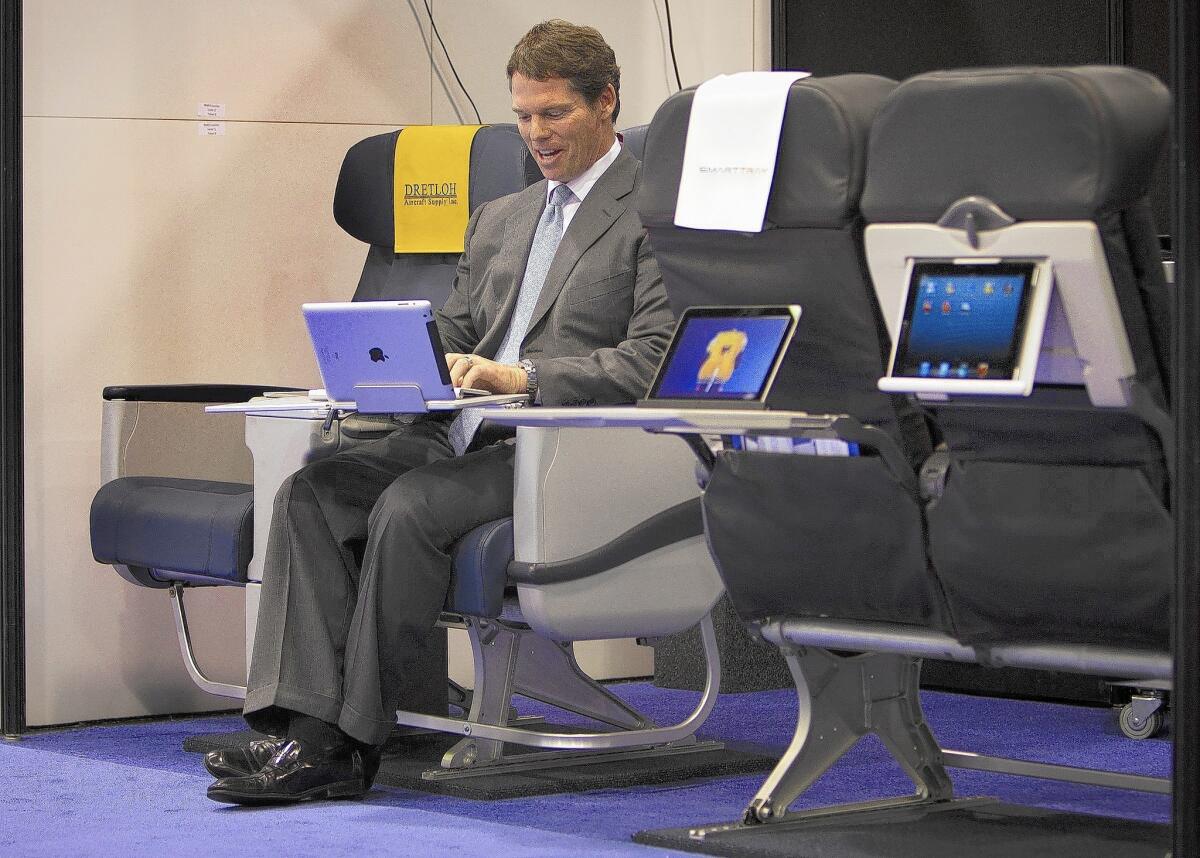Airlines take different approaches to in-flight entertainment

- Share via
In their ongoing quest to squeeze more revenue out of passengers, airlines are split on a big potential moneymaker: in-flight entertainment.
Large carriers such as Delta Air Lines have invested heavily in touch-screen entertainment systems that are built into seat backs. Southwest Airlines and others offer only onboard wireless Internet so passengers can watch movies and television shows using their own tablet computer or smartphone.
A few airlines have installed both systems.
“Airlines are taking very different approaches because each airline has a different perspective on how they run their business,” said Henry Harteveldt, a travel industry analyst for Atmosphere Research Group.
What kind of in-flight entertainment an airline offers reflects the type of passenger carriers are targeting. Airlines with seat-back systems are going after well-heeled fliers with money to spend on onboard food and entertainment. Carriers with only Wi-Fi hope to attract thrifty travelers looking for the cheapest airfare.
The split was illustrated at a recent airline industry expo in Anaheim, where manufacturers of touch-screen entertainment systems shared the exhibition floor with makers of onboard Wi-Fi equipment.
Big money is on the line. The nation’s airlines pocketed $27.5 billion last year from onboard sales of food, liquor and entertainment and all other revenue besides fares, baggage fees and reservation change charges.
There are drawbacks and benefits for each entertainment system.
Seat-back systems can cost as much as $6 million and weigh as much as 600 pounds per plane, depending on the size of the aircraft. But the systems can generate hefty revenues by letting passengers buy food, drinks and entertainment with a touch of the screen.
Passengers on Virgin America, for example, can swipe a credit card on the seat-back system at takeoff and keep a tab open for an entire flight.
“We have seen really good results with that,” said Virgin America spokeswoman Abby Lunardini.
Airlines that offer only onboard Internet call their entertainment strategy BYOD, or Bring Your Own Device. Onboard Wi-Fi systems weigh only 70 or 80 pounds.
By eliminating the weight of the much heavier seat-back system, BYOD carriers save as much as $50,000 a plane a year on fuel costs — which they say helps to keep their fares low.
That was partly why WestJet of Calgary, Canada, announced this year that its entire fleet will offer only onboard Wi-Fi, plus charging outlets at each seat. The airline also rents tablets to passengers who travel without one.
“With the vast majority of our guests already bringing on board their own devices, it makes sense for us to provide them with the content they want on the device they want to watch it on,” said Robert Palmer, a spokesman for WestJet.
For some passengers, in-flight entertainment can make a difference in which airline they fly.
Jerry Madison, a sales and marketing executive from Los Angeles, said he would switch to Virgin America if he could after using the airline’s entertainment system on a recent trip.
“Nothing like that on American or United,” he said. “It was quite impressive.”
Industry experts predict that more airlines will remove the heavy and expensive seat-back entertainment systems and rely only on onboard Wi-Fi and streaming systems as the technology for wireless streaming improves to eliminate Internet slowdown.
“The days in which the airline is intent to provide entertainment to every seat back, I think those days are disappearing,” said Jay Sorenson, a consultant to airlines on increasing passenger revenue.
Nick Pajic, an engineer from Phoenix, hopes Sorenson is right.
During a flight home a few years ago, Pajic’s iPad tablet tumbled off his tray table and broke, spurring an epiphany to build a tray table specially made to hold tablets and smartphones.
Pajic’s invention, the SmartTray, has built-in clamps and grooves to clasp the devices, making it easier for passengers to use them to read, play games and watch movies and television shows. The SmartTray is already in use on Asia Atlantic Airlines, and Pajic expects to get major U.S. airlines interested in his invention.
The tray table can even hold a tablet or smartphone when the table is in the upright position.
“It’s pretty cramped already,” he said. “If we free up the tray table space, we will make passengers happier.”
More to Read
Inside the business of entertainment
The Wide Shot brings you news, analysis and insights on everything from streaming wars to production — and what it all means for the future.
You may occasionally receive promotional content from the Los Angeles Times.











